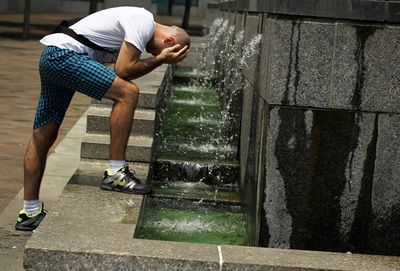(1) As this is written, it it is 84 degrees in the Twin Cities. It is 90 degrees in Phoenix. But we don’t get to say “but it’s a dry heat.” Our heat stinks, but the heat index is still higher in Phoenix (89.2) than it is in the Twin Cities (86.5). So all things considered, things could be worse. You could live in Phoenix. By the way it’s 11 degrees hotter in Washington than the Twin Cities. So it could be worse. You could live in Washington. Then again, that’s always true at any temperature.
(2) When the temperature hits 95, according to NASA, your output at work drops by 45 percent. Your loss of accuracy is 500 700%.
(3) You’ll lose weight in the heat. But you’ll gain it back with water and food. Sorry.
(4) On average, heat waves kill more people than any other natural disaster in the U.S. About 1,000 people a year die in the U.S. from the heat.
(5) Men are more susceptible to a problem in the heat because they sweat more than women do.
(6) Although official warnings of heat stroke suggest not drinking alcohol or caffeine during a heat wave, a 2011 study concluded there is not definitive proof that alcohol consumption is a major contributor. It also found little compelling evidence that moderate caffeine intake impairs either heat dissipation in the body nor affect hydration. Bottoms up, my friends!
(7) The heat stored by roofs, pavement, and concrete structures can raise the night temperature in cities by as much as 22 degrees.
(8) Body temperature can rise to 105 degrees if working outside in a heat wave. Death occurs usually when a body temperature reaches 107.6.
(9) On a day that is 93 degrees, the inside of a car can reach 125 degrees in 20 minutes. At 106, dogs die quickly. Leaving a dog locked in a hot car in Minnesota is a misdemeanor punishable by only a $25 fine.
(10) Want to escape the heat? Go up. The temperature drops 3.5 degrees for every 1,000 feet. At 6,000 feet, it is barely 70 degrees. Unfortunately, the highest point in Minnesota is Eagle Mountain in the Boundary Waters at only 2,301 feet.

